THIS FEATURE IS CURRENTLY
BEING CREATED
|
|
Interspersed
throughout this feature are text boxes such as this one,
which will present you with concurrent events taking place
in Tampa as told by James McKay, Jr. in "Reminiscences -
History of Tampa in the Olden Days" Dec. 18, 1923.
His accounts offer a unique view of Tampa's history as he lived
it.
His father was
a well-known personality, the "Scottish Chief" of
Tampa, a daring and enterprising businessman and mayor of
Tampa, and a Tampa icon. McKay Jr. later also served as a mayor of Tampa, as
did one of McKay Jr's. nephews, Donald Brenham McKay.
James McKay,
Jr., was born in Mobile, Ala., in 1842 and moved with his
parents to Tampa in 1846. In his later years he wrote two
lengthy articles about the early history of Tampa and
Hillsborough County. The first was printed in the Tampa
Times, Dec., 20 1921, and was later reprinted in D. B.
McKay’s Pioneer Florida. The second article (the one
presented in the feature) appeared in the Tampa Times, Dec.
18, 1923.
There have been many articles published by the press of the
early days of Tampa, composed by those who obtained their
information from hearsay and not personal knowledge, that
were only partly correct. I will, to the best of my memory,
relate what I know from the late 1840s and 1850s of what
Tampa was then, and its slow but substantial growth to the
1870s...Our family came to Tampa from Mobile, Ala. in 1846.
|
|
At that time
there were but few citizens who were civilian and but few
houses outside of the government reservation. The military
post was known as Fort Brooke, garrisoned by the Fifth
Infantry, and commanded by Colonel Waite. There was but one
store, owned and operated by W. G. Ferris, on the
reservation. He was known as the
sutler
for the post. These stores are now
called post exchange at army posts.
James
McKay, Jr. in "Reminiscences - History of Tampa in the
Olden Days" Dec. 18, 1923
|
|
The north side of the government reservation
ran east and west along Whiting street. The town was
situated north of this line, and was a bed of sand and thick
growth of what was called the scrub. The post office was on
the reservation. At the time our family came to Tampa, the
postmaster was Dr. John M. Palmer. He constructed a small
hotel on the north side of Whiting street near the river and
named it the Palmer hotel. This was a building containing 10
or 11 rooms, with a dining room the entire length of it on
the back, and about 15 feet wide, which was used later on as
a dance hall for the young people. Colonel Hugh T. Fisher was the manager of this
hotel. He became the postmaster June 10, 1850. Colonel
Fisher was the grandfather of our present deputy sheriff,
Mr. Brooks.
In 1846 Darling & Griffin opened a store at
the corner of Whiting and Tampa streets. Later on the name
of this firm was changed to Kennedy and Darling. My father
also opened a small store in 1850, at the corner of
Washington and Franklin street, where the Tampa Daily Times
is now published.
James
McKay, Jr. in "Reminiscences - History of Tampa in the
Olden Days" Dec. 18, 1923
|
In 1848, the
town was visited by a terrific hurricane causing the tide to
rise above 15 feet above low water mark, washing away the W.
G. Ferris store and the house we were living in; in fact,
most of the houses that were located on the river bank. Our
family was moved to the Palmer hotel, and when driven out of
there on account of the tide, to the Darling and Griffin
store, and then to the military hospital on the reservation.
The Palmer Hotel withstood the hurricane, although the water
rose two feet over the main floor.
As soon as Mr. Ferris could obtain material he erected a
small building on the south side of Whiting street near the
intersection of Franklin, which did not extend farther
south, on account of the reservation. A few years later Mr.
Ferris, having some trouble with the military officials, was
ordered off the reservation, so he moved his store to the
corner of Florida and Washington streets and built his
residence on the same lot. This residence became the old
folks home and later on was moved to the site the home is
now occupying and somewhat improved, or made larger.
by James
McKay, Jr. in "Reminiscences
- History of Tampa in the Olden Days" Dec. 18,
1923
|
|
In 1848-49-50 my father owned and operated
the schooner Sarah Matilda (named for my mother) between
Tampa, Mobile and New Orleans. With the exception of the
government vessels, this was the only vessel that was being
used commercially for this port. He also constructed a twin
wharf at the foot of Washington street. Cattle were penned
between the wharves, for shipment to Key West, by schooner.
The Indians having moved to the Everglades
and the country being in a peaceful condition, many settlers
came into the country and some located in Tampa, purchasing
lots and building homes, clearing up the scrub as they would
build, putting down plank sidewalks and in some instances
shell, but the sand remained in the streets making it hard
on teams as well as pedestrians. No lot of 105 feet by 105
feet sold for more than $25 or $140 for the square. That is
what our family paid for the lots where the Olive hotel is,
also The Times lot, and the Almeria hotel square.
by James
McKay, Jr. in "Reminiscences - History of Tampa in the
Olden Days" Dec. 18, 1923
|
The first Masonic lodge was organized, I think, in 1850 and
the upstairs of my father’s store was fitted up for holding
their meetings, and later on I think in the later part of
1852, the lodge building at the corner of Whiting and
Franklin street was erected, first a two-story building, the
upstairs for a lodge and the lower floor used principally
for school purposes, and later on an addition of a two-story
building at right angle to the first one, was constructed. I
am under the impression that my father was one of the
charter members of this lodge, and had as much if not more
than any other citizen in its organization and construction
but later on had a difficulty with one of the members,
withdrawing from the lodge, saying he would never enter it
again as long as this party was a member, and I do not think
that he ever attended a lodge meeting after that. I am under
the impression that he had several hundred dollars of stock
in this organization which he lost for some reason. If I
have made incorrect statements in reference to this matter
and the lodge has records on file in regard to it, I would
be very glad to be put right in the matter. We children
attended school in this lodge building. Rev. J. K. Glover, a
Methodist minister, was the teacher.
by James
McKay, Jr. in "Reminiscences - History of Tampa in the
Olden Days" Dec. 18, 1923
[James McKay, Sr. became a member of Hillsborough Lodge
No. 25, F&A.M. Apr. 10, 1850. He was expelled Dec. 15,
1855 due to a dispute with fellow Mason Madison Post.
McKay was reinstated in the lodge, Sept. 5, 1863.]
|
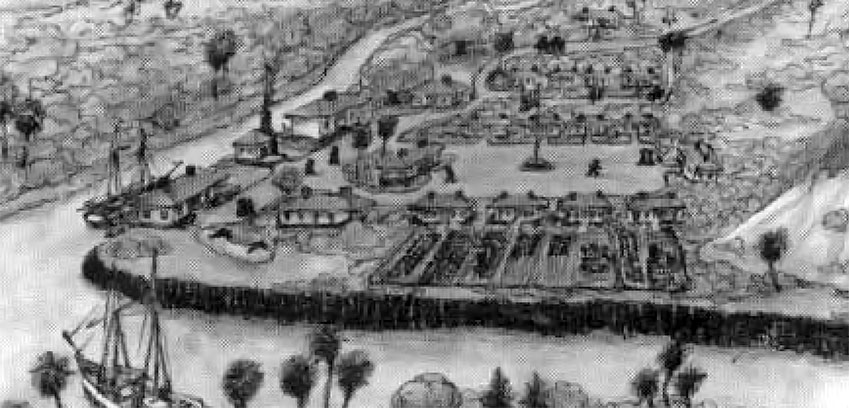
Artist's sketch of
Ft. Brooke as it appeared in 1850
Image from The Mayors of Tampa 1856 - 2015
|
In 1851 we shipped cedar logs that were cut from up the
Hillsborough river, to Blanchard and Fitch in New York, for
making pencils. In 1851 my father erected a saw mill at the
place where the Tampa Steam ways is now situated, for the
manufacture of lumber. Previous to this, all lumber was
freighted from Mobile. Sawdust from this mill was placed on
the municipal streets to assist teams in hauling. When the
yellow fever appeared in town many of the citizens claimed
it was from decayed sawdust and the practice was stopped.
Fort Myers was established, I think, in 1850 by the
government. My father was appointed
sutler of this post in 1852 and used a small schooner
named Emma to take his goods from Tampa to Fort Myers. He
also opened a store at Fort Denaud, which was on the
Caloosahatchee river some 20 miles above Fort Myers and
chartered a little steamer he owned, named the Woodduck to
the quartermaster department to carry supplies to the troops
at that place. She was operated between Punta Rassa, Fort
Denaud, and Fort Myers.
The mails were brought to Tampa overland from Gainesville by
stage first weekly, then semiweekly, under contract with my
father in 1852. The first court house was constructed in
[1848] and the second and larger court house was built by
the Rev. John H. Breaker, being a two-story building in
[1854].
by James
McKay, Jr. in "Reminiscences - History of Tampa in the
Olden Days" Dec. 18, 1923
|
|
In 1852 we opened a ferry at the foot of
Jackson street, so as to cross the stage with the mail. It
was also used by the public. Ponds that were located on the
east end of Jackson street caused the city officials as well
as the people, considerable annoyance, especially during the
rainy season. One of these ponds at the corner of Jackson
and Marion street would take in all four corners and prevent
pedestrians from passing in that direction. I have skated
rocks over ice on this pond when it was frozen over during
the winter.
The authorities dug a ditch in the center of
Jackson street to drain these ponds, and in some places it
was 12 feet deep. Across Franklin and Tampa streets small
bridges were placed so as to permit passage of teams and the
public. This did not accomplish what was desired so the
ponds were filled in later on.
by James
McKay, Jr. in "Reminiscences - History of Tampa in the
Olden Days" Dec. 18, 1923 |
|
It
has been remarked that Tampa had not been visited with a
hurricane since 1848 until the one of 1921, which is an
error, Tampa was visited with a pretty stiff hurricane in
1853, that I recollect very well. The schooner John Roalef
owned by W G. Ferris and sons arrived from New Orleans with
a cargo of general merchandise and just as she had finished
discharging this cargo, this hurricane came along, bringing
in a tidal wave with it that landed this vessel about 100
yards north of the A. C. L. railroad warehouse where it
stands now and about 100 yards from the river bank. My
father bought this vessel, had her jacked up and repaired,
dug a canal to the river and launched her into this canal,
floating her. The tide must have risen some 10 feet above
low water mark as this vessel was drawing some five feet or
more of water, at the time she went ashore.
by James
McKay, Jr. in "Reminiscences - History of Tampa in the
Olden Days" Dec. 18, 1923 |
|
In 1855 the Morgan Steamship Line operated
their steamers between New Orleans and Havana, touching at
all the Florida ports semi-monthly, which also gave the town
mails, freights and passengers. The Leonardy brothers
conceived the idea of erecting a hotel of some 25 rooms on
the lot occupied by the Scottish Rite building, naming it
the Florida House. This building my father purchased from
them and operated as a hotel until the beginning of the war.
It was full every winter, with tourists who visited the town
for their health.
by James
McKay, Jr. in "Reminiscences - History of Tampa in the
Olden Days" Dec. 18, 1923
|
|
In 1857 during the
summer, Tampa was visited by an epidemic of yellow fever, but it being very late
in the summer and cold weather coming on, there were not many cases and but few
deaths, but in 1858 it started early in the season and spread rapidly over the
town. All that could move to the country did so but there were many deaths, some
of our best citizens passing away. I was stricken with the disease and only for
my mother and grandmother, being most excellent nurses, they having passed
through an epidemic in Mobile sometime previous, I would not be here today
writing this article.
There were many theories advanced from what source came
the disease. Some stated that it was introduced from New Orleans by schooner.
Others claimed it originated from filth in the town. Any way there was a
campaign of cleanliness and sanitary measures were adopted in the winter of ’58
and early ’59. These measures were rigidly enforced and before the summer of ’59
came in, the town, was placed in fine shape. But it gave the town a setback from
which it did not recover for two years.
by James
McKay, Jr. in "Reminiscences - History of Tampa in the
Olden Days" Dec. 18, 1923
|
James McKay's Motive to Remove Magbee
The cattle
trade to Cuba was being initiated and McKay intended to bring
back certain items such as cigars, rum and sugar. In order for McKay and
the other cattlemen to avoid the national tariff laws, Magbee
would have to be removed and replaced by a “more amenable
collector."
As McKay's prosperity boomed with the cattle business, he took
an increasingly strong role in Tampa business and political
affairs.
In both he associated closely with a group
of men that included, among others, William Brinton Hooker,
merchant Madison Post, and lawyers Joseph M. Taylor and James Gettis.
Politically, they battled the regular Hillsborough County
Democratic party which loosely was
centered upon lawyer and former legislator James T. Magbee.
McKay’s faction in 1858 ousted Magbee from his important federal
position as collector of the port of Tampa, and the following year
McKay was elected to a one year term as mayor.
|
In 1858 my
father came to the conclusion the country would be benefited from the
exportation of cattle to Havana, Cuba, so he purchased the brig Huntress, fitted
her up with cattle pens and contracted with the Morgan Steamship Line to load
their decks twice each month, paying $1,500 per trip, whether he loaded the
decks or not. He constructed a small dock at Ballast Point and lightered the
cattle out of these vessels. Through this source quite a sum of money was placed
in circulation in south Florida. In fact after the military left this part of
the country the shipment of cattle was the only source of obtaining money. There
was only a small amount of sea island cotton made in this section and some
potatoes, sugar and hides. These were brought to town and sold in trade, for
other goods.
by James
McKay, Jr. in "Reminiscences - History of Tampa in the
Olden Days" Dec. 18, 1923
|
|
|
James Mckay,
Sr. - 6th Mayor Of Tampa
He was the only non-U.S. citizen to serve as Mayor
of Tampa.
He remained a citizen of the United Kingdom
throughout his life.
Born: May
17, 1808
Died: November 11, 1876
Term: February 12, 1859 - February 1, 1860
Captain
James McKay was a most unusual man, physically and mentally.
Over six feet tall, he weighed a hundred and ninety pounds
and there was not an ounce of fat on his body. He was
broad-shouldered and had the muscles of a prize fighter. He
was a born leader and for three decades was one of the most
out· standing men in south Florida.
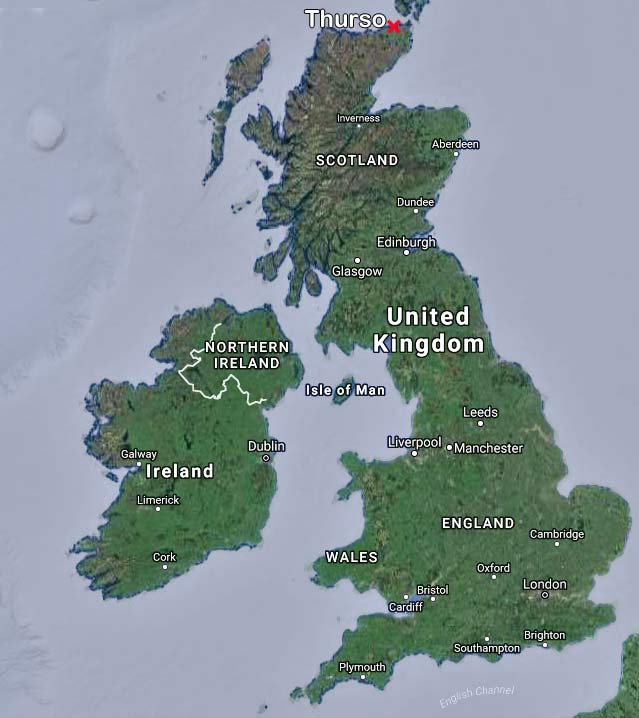
James McKay,
Sr. was born in
Thurso, Scotland, May 18, 1808*,
in the County
of Caithness. For generations, Caithness was the ancestral home
of this sterling Scottish family, whose lineage runs back in
unbroken lines to the time of Robert Bruce and Mary, Queen
of Scots.
*Grismer
says March 17, 1809
McKay went to sea when a boy and became a master seaman
before he was twenty-five. As a mariner, he spent most
of his time at sea but would return for brief periods to
visit his family.
The two sources
below detail the life of James McKay, Sr., but they differ
somewhat on the subject of when he came to America, where he
went first, and when he first met and then married Matilda.
They do agree, however, on their marriage taking place in
the U.S. Their versions are presented below,
side by side. The
City of Tampa Mayors website is incorrect on the bios of
James McKay Sr. and James McKay Jr. They claim James
Sr. met and married Matilda and had their first four children
in Scotland before coming to the US around 1846, and that
James Jr. was their oldest son, born in Scotland.
Reputable historians and authors do not support the city's
version, yet it is repeated word for word all over the web,
including Wikipedia. Three consecutive censuses
support the versions that present the birth of all the McKay
children in the United States--the first four in Alabama.
Interspersed among the two columns, are excerpts from
Charles E. Harrison's
Genealogical records of the pioneers of Tampa and of some
who came after them, published in 1915. |
|
History of Florida: Past and Present, Historical and
Biographical, Volume 2, pub. 1923 By Harry Gardner
Cutler.
Text version available at USGenWeb Archives. |
Tampa-A history of the city and the Tampa Bay region of
Florida, by Grismer, Karl H, edited by Mckay, D. B, 1950
(Grismer had the advantage of working with Donald B. McKay,
James Sr's. grandson.) |
|
In 1828,
James McKay came to America, locating first in New Orleans,
where for a period of nearly two years he was engaged in
carpentry and building.
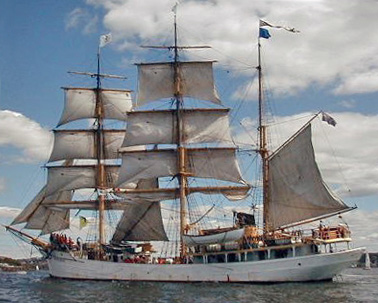
It could
have taken 6 to 12 weeks to cross the Atlantic from Scotland
in a 3-masted barque such as this one. Read more at
the source of this photo: "Crossing
the Atlantic" at Ormiston.com.
He next
located in St. Louis, Mo, where in 1837 he met and married Matilda
Alexander Cail , a native of Scotland, born in Edinburgh, May
19, 1816.
Genealogical records of the pioneers, etc., by
Charles E. Harrison, pub. 1915, states:
"They
never met in the old country, but first became acquainted
with each other in St. Louis, Mo., after both had
immigrated to America. They were married there in
1837. From St. Louis they removed to Mobile, Ala., where
Mr. McKay engaged in mercantile business."
In 1838 James and Matilda moved to Mobile, Ala, where the
couple had their first four children: George, Sarah
I., James Jr. and John Angus.
At Mobile, he first worked as a carpenter and builder, but
in 1842 he entered into a partnership with a man named
Brighton, and established a
willow-ware business under the name of McKay and
Brighton. The venture proving unsuccessful, he disposed of
the business in 1846.
Purchasing a small schooner, he brought his family--his
wife, four children, and his mother-in-law to Florida,
locating first at a small place north of Tarpons Springs.
The location was not a favorable one, so he took his family
to Brooksville, where he secured teams and wagons and
continued on to Tampa, arriving at here in September, 1846.
Genealogical records of the pioneers, etc., by
Charles E. Harrison, pub. 1915, states:
They
removed to Florida from Mobile in 1846 and settled first
at Chassewiska, on the coast of Hernando County. They did
not remain long, however, at that place and in the same
year, 1846, removed again, this time to Tampa, which has
been the family home ever since.
|
While in
Edinburgh one day in 1835, James met a bonnie Scotch lass,
Matilda Cail, with whom he fell in love. But Matilda was
then only sixteen years old, altogether too young to be
married, in the opinion of her mother, Madame Sarah Cail. To
remove her daughter "from temptation," Madame Cail left
Scotland and went to America, taking Matilda with her. They
settled in St. Louis. [Probably by way of New Orleans,
then up the Mississippi River]
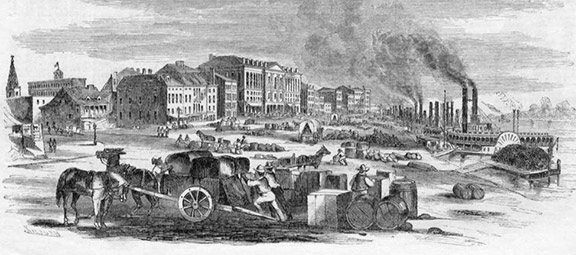
By the
1830s, it was common to see more than 150 steamboats at the
St. Louis levee at one time. Immigrants flooded into St.
Louis after 1840, particularly from Germany.
Wikipedia: 1857 illustration from Ballou's Pictorial
Drawing Room Companion, Boston, Massachusetts. The Levee or
Landing, St. Louis, Missouri, 1857.
Not to be
outwitted so easily, Captain McKay followed, found the Cails
in St. Louis and immediately resumed his courtship. In 1837,
Madame Cail finally relented and gave permission to Matilda
to be married. The captain was then twenty-eight years old
and his bride seventeen.
Soon after the wedding they moved to Mobile, Ala., where the
captain engaged in the mercantile business.
In
Mobile, Captain McKay met the Rev. Daniel Simmons, the
Baptist minister who had established a mission in
Hillsborough County in 1828 and had lived there until the
Seminole War started, when he went to Alabama. Reverend
Simmons was an ardent Florida booster and never ceased
singing the praises of the Tampa Bay region. Captain McKay
did not need much selling on the future prospects of the bay
section. He knew that because of its geographical location,
Tampa Bay was destined to become one of the leading ports of
the nation. So in the early fall of 1846 he decided to go to
Tampa.
Chartering a schooner, Captain McKay left Mobile with his
family in September, 1846. Reverend and Mrs. Simmons went
with him, and so did Madame Cail and Mitchell McCarty and
his wife, Elizabeth, daughter of the Simmonses.
The
schooner never reached Tampa. It was wrecked during a
hurricane on shoals in Chassahowitzka Bay, in Hernando
County. The cargo was lost but all on board escaped. The
Simmons and McCarty families went on to Brooksville but the
McKays soon afterward made their way to Tampa, arriving in
November. Madame Cail came with them.
[TampaPix
opinion: Perhaps more D.B. McKay drama?] |
|

This pencil sketch of the
Captains' Quarters at Fort Brooke was drawn by one of the
officers stationed there in 1845. Beyond the majestic,
moss-laden oak tree at the left is seen the ancient Timuquan
ceremonial mound enclosed by a fence. Leading from the gate
is a path that forks to the left and to the right towards
the top of the mound where a small Chinese summer house was
perched. The ladies of the fort had socials there. Beyond
the small cottage to the right of the mound is a glimpse of
Hooker's Point. The first three large dwellings to the right
of the cottage were the officers' quarters. The fourth
building was occupied by Rev. Henry Axtell, the Army
Champlain, his wife Juliet, and two of their daughters. The
last building to the right was the chapel with its broad
portico and small front yard set out with mulberry trees.
Wide shell and gravel walks criss-crossed the post. The
sketch has been preserved by the family of Chaplain Henry
Axtell for over 150 years. |
|
The first
home of the McKay family in Tampa was a crude structure at
Fort Brooke, situated on the riverbank at the foot of
Whiting St. This building, which was rented from the
Government, was totally destroyed in the disastrous
hurricane which swept over the post in 1848.
The next location of the McKay home was at the corner of
what became Tampa and Lafayette Street, which was later
occupied by Knight & Wall Co. McKay purchased half the block
for $50 and built his home there. The building was of log
construction, and the lumber used for finishing it was
brought by boat from Mobile, Alabama.
Later, he purchased the block on the northeast corner of
Washington & Franklin St. for $100 and a more commodious and
modern home was built there. On the south side and
opposite corner, was located the building McKay used as a
warehouse and general store, where for many years his
merchandising and other business interests were located.
Capt. McKay became a dominant factor in the up-building of
the community. He established a line of schooners from Tampa
to New Orleans, thus giving to the city business a
connection with the outside world. He built a sawmill on
what was then the outskirts of town, at what would become
the Tampa Heights area on the Hillsborough River, supplying
the town's needs for building purposes.
He accepted contracts to build the first non-log cabin
courthouse for Hillsborough County and carry the mail from
Tampa to Gainesville. He built and owned the only wharf in
the harbor.
He owned and operated steamers and sailing vessels, and with
these made large shipments of cattle from Florida to Cuba.
He established this business in 1855, thereby putting a
great deal of money through is purchases of cattle in South
Florida.
By personally guaranteeing the company against financial
loss, he induced the Morgan Steamship Company to have two of
their vessels, on the route from New Orleans to Havana, make
semi-monthly calls at Tampa and other points in Florida.
This was in 1856 and the same year he established a
merchandising and trading business in Fort Myers, another
post garrisoned by US troops.
He expanded this business until it attained such
proportions that in 1859 he fenced off the Gadsden Point
peninsula, the fence extending from where the Spanish
sanitarium stood to a point on Old Tampa Bay, about a mile
north of today's Port Tampa, and in this pasture grazed
thousands of head of cattle in preparation for their
shipment to Cuba.
McKay was
joined in this endeavor by other Hillsborough County
residents, notably the Lesleys, Lykes and Hookers. [Tampa
Bay History Center Blog] |
Both
Captain McKay and Madame Cail were well off and soon after
arriving in Tampa they began investing heavily in real
estate, buying some of the best blocks in town as soon as
the property was put on the market. They also purchased many
large tracts throughout the county, becoming two of
Hillsborough's largest land owners.
Genealogical records of the pioneers, etc., by
Charles E. Harrison, pub. 1915, states:
Some of the older children of this family were born before
their parents' arrival in Tampa, but the majority of
them...were born here. The family was a large one,
consisting of George, James, John Angus, Donald S. and
Charles; sons, and Sarah, Marion, Matilda and Almeria
Belle; daughters.
One of the blocks purchased
by Captain McKay was the one bounded by Franklin, Jackson,
Florida and Washington Streets. There he built his home. On
another of his blocks, the one adjoining on the south, he
built a store building and went into business. But he was
not long satisfied with store keeping.
Late in 1848 he purchased a
schooner, naming her
the Sarah Matilda, and started making runs to Mobile
and New Orleans.
Two years later he bought another schooner
Emma, for use between Tampa and Fort Myers.
During the 1850s
he added to his fleet, buying the 125-ton steamer Venice, a
smaller steamer called the Woodduck, and the brigantine
Huntress, purchased at federal auction in Key West after it
had been condemned as a slaver.
In 1859 he chartered the
steamer
Magnolia from the Morgan Line and entered the cattle
business, buying herds and selling the them in Cuba. He
is credited with being the first shipper of cattle from
Florida to the Cuba market.
|
Magnolia, a wooden, seagoing, sidewheel steamer built
by J. Simonson of Greenpoint, New York for Charles
Morgan's Southern Steamship Company. Launched in 1854,
the ship was impressed as a public vessel in New
Orleans, Louisiana, 15 January 1862, by Maj. Gen.
Mansfield Lovell, CSA, acting for the Confederacy's
Secretary of War Judah P. Benjamin. The South’s
original plan to arm her as a ram was dropped in favor
of turning her into a blockade runner. In 1858
Floridian cattle man Captain James McKay Sr. of Tampa
made a contract with the Morgan Line. This contract
allowed McKay to use Magnolia twice a month at a price
of $1,500 each run in order to ship cattle to Cuba,
making Magnolia the first of many ships to be used in
the same way. For this reason, the introduction of
Spanish doubloons to Florida can be traced back to the
trading trips made by Magnolia. |
|
|
The rest below
is from
City of Tampa Mayors: |
|
McKay served
as Tampa's 6th mayor, from February 12, 1859 to Feb.
1, 1860, and established the use of standard procedures and
forms for licenses, ordinances and legal notices. He also
regulated the Jackson Street ferry service in town to ensure
the safety of passengers and cargo. McKay also attempted to
purchase the Fort Brooke military reservation for Tampa but
was only able to negotiate a rental agreement. For eighteen
months, the City rented Fort Brooke from the U.S. government
until April 1861 when Confederate troops occupied the fort
and declared marshal law in Tampa.
With the
outbreak of the Civil War, McKay and a handful of other
local men used their vessels to run the Union Naval Blockade
to bring guns, ammunition, foodstuffs and other merchandise
for the Confederate army and civilian population in Tampa
and the surrounding area. At the same time, he
provided beef cattle and supplies to the Union troops in Key
West and the Tortugas.
(More on
this and his capture is presented further down in this
feature).
In 1863, after
his release from imprisonment in Key West, Confederate Major
Pleasant W. White appointed McKay Commissary Agent for the
5th District of Florida. True to his promise made to the
Union, McKay seems to have frustrated attempts to supply the
Confederate army with beef using a series of excuses ranging
from "bad weather, lack of funds, a scarcity of cow hunters
and drivers and poor health." As a result, the cattle
shipments that did arrive from Florida were far below the
needs of the Confederate Army. Extremely displeased with the
number of cattle being transported to the army, the
Confederate government conducted inspections of the cattle
and methods of supply but could not determine if there were
intentional delays.
After the
war, McKay resumed his cattle and shipping business until
1876 when he had an accident from which he never fully
recovered. He died in Tampa on Nov. 11, 1876. |
|
McKay Family Censuses in Tampa
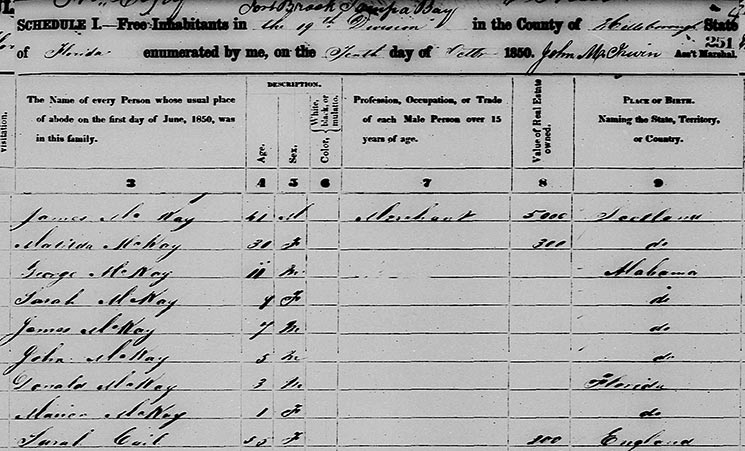 |
|
Their 1850
Census shows James & Matilda's first four children, George,
Sarah, James & John, all born in Alabama.
Donald and Marian born in Florida, and Sarah Cail, Matilda's
mother, born in England.
|
|
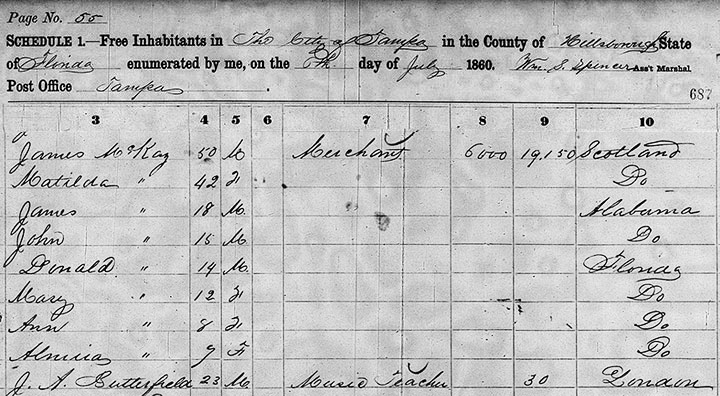 |
|
1860 Census of the McKay Family in Tampa
The McKay's had a music teacher from London in their
household--J.A. Butterfield.
See the table of combined census info below for explanation
of names.
|
|
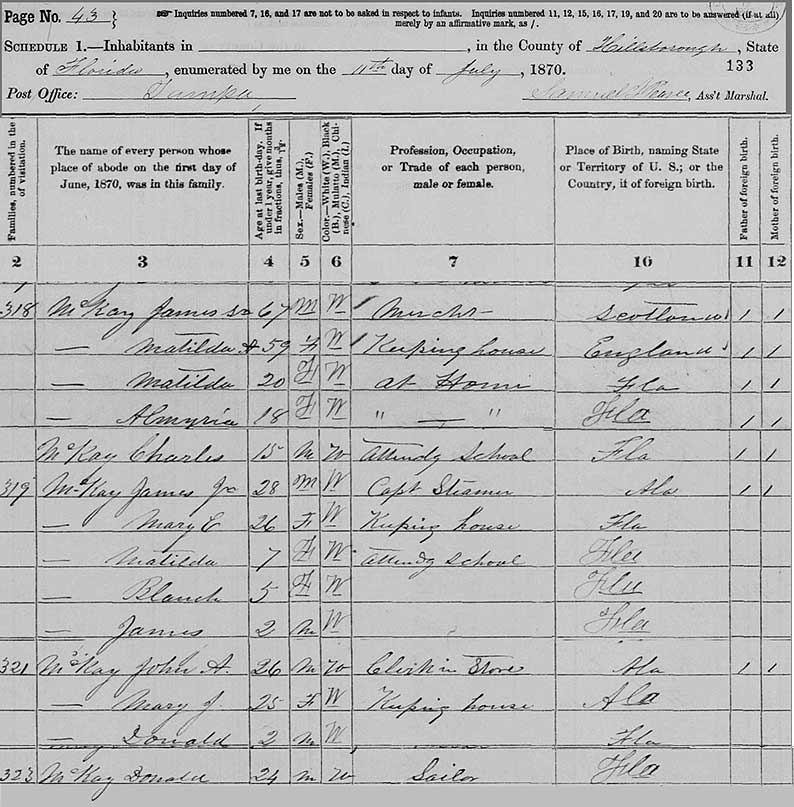
1870 Census of
McKay family members
It wasn't until the
1880 census that the relationship to head of house for each
person was recorded.
Res. 319 James Jr. now married to Mary E. (Chrichton) with 3 children,
Res. 321 John A. married to Mary J. (McCarty) with son Donald.
(This is Donald Brenham McKay.)
Res. 323 Donald (S.) now living in his own residence.
Enumerator failed to record a "1" for
"Parents of foreign birth" in Col. 11 & 12 for Donald.
This census has been pieced together from 2 successive
pages; the 2nd page starting with 15-year old Charles McKay.
(See table below for notes concerning Charles.) |
|
McKay Family Census Comparisons
|
Name |
|
Census Names |
|
Age |
Calculated Birth Year |
Birth Place |
|
1850 |
1860 |
1870 |
1850 |
1860 |
1870 |
1850 |
1860 |
1870 |
1850 |
1860 |
1870 |
|
James Sr |
James |
James |
James Sr. |
41 |
50 |
67 |
1809 |
1810 |
1803 |
Scotland |
Scotland |
Scotland |
|
Matilda |
Matilda |
Matilda |
Matilda A. |
30 |
42 |
59 |
1820 |
1818 |
1811 |
Scotland |
Scotland |
England |
|
George |
George |
D |
D |
11 |
D |
D |
1839 |
D |
D |
Alabama |
D |
D |
|
Sarah I. (Thomas) |
Sarah |
Sarah |
NF |
9 |
20 |
NF |
1841 |
1840 |
NF |
Alabama |
Mobile, Ala |
NF |
|
James Jr |
James |
James |
James Jr. |
7 |
18 |
28 |
1843 |
1842 |
1842 |
Alabama |
Alabama |
Alabama |
|
John Angus |
John |
John |
John A. |
5 |
15 |
26 |
1845 |
1845 |
1844 |
Alabama |
Alabama |
Alabama |
|
Donald S |
Donald |
Donald |
Donald |
3 |
14 |
24 |
1847 |
1846 |
1846 |
Florida |
Florida |
Florida |
|
Marion E. (Randolph) |
Marion |
Mary |
Marion |
1 |
12 |
21 |
1849 |
1848 |
1849 |
Florida |
Florida |
Florida |
|
Matilda Ann (Wall) |
NA |
Ann |
Matilda |
NA |
8 |
20 |
NA |
1852 |
1850 |
NA |
Florida |
Florida |
|
Almeria Belle (Lykes) |
NA |
Almeria |
Almyria |
NA |
7 |
18 |
NA |
1853 |
1852 |
NA |
Florida |
Florida |
|
Charles M. |
NA |
NL |
Charles |
NA |
NL |
15 |
NA |
N.L. |
1855 |
NA |
NL |
Florida |
|
NA=Not Applicable |
NL=Not Listed |
NF=Not Found |
D=Deceased |
|
|
|
|
|
|
George died 1859, buried in Oaklawn
Cem. |
|
|
|
|
|
|
|
|
|
|
|
Charles first appears on the 1870 census where he is
listed out of order and with parents showing foreign
birth; he was omitted on the previous census, 1860.
Oaklawn Cemetery marker: b. Jan 3, 1857, d. Sep
15, 1877. In 1874, His brother John A. McKay had a son
named Charles.
Genealogical records of the pioneers, etc.,
by
Charles E. Harrison, pub. 1915, states:
-
George, the first
son, died in early manhood, unmarried.
-
Sarah, married
Robert B. Thomas of Kentucky.
-
James Jr. married
Mary E. Crichton, the mother of all his children,
2nd to Helene Turton, of Mass., and 3rd time to
Lillian Nimms Warren, of NJ.
-
John Angus married
Mary Jane McCarty.
-
Donald S. was
born at Chassewiska, Aug 8, 1846, and came to Tampa
with his parents in the same year. He married Mary
M. Collier, then 2nd to Martha A. Hayden.
-
Marion
E. married
William Randolph of Tallahassee.
-
Matilda
Ann married Dr.
John P. Wall.
-
Almeria Belle
married Howell T. Lykes, of Brooksville.
-
Charles McKay
was not
mentioned by Harrison. Charles died at
age 20 in 1877.
|
|
THE JAMES MCKAY,
SR.
HOMESTEAD |
|
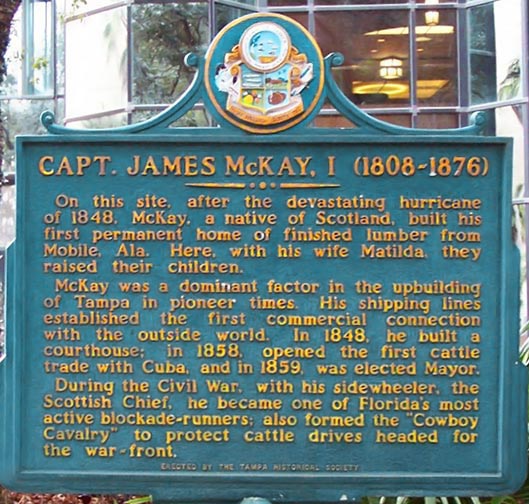 |
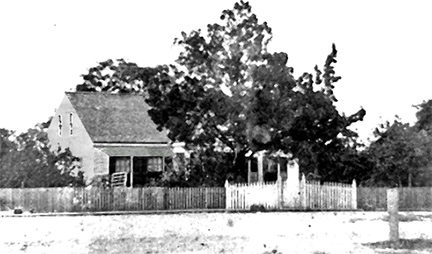
THE OLD McKAY
HOMESTEAD
This was the homestead of Capt. James McKay. This view shows
the home in the 1870s, and was located on the southeast
square of Franklin and Jackson Streets, the present-day site
of the Tampa City Center skyscraper. The McKay children were
reared in this house.
Photo courtesy of Helen McKay Bardowsky
Historic marker from Exploring Florida
McKay homestead from
THE SUNLAND TRIBUNE Volume VIII Number 1 November, 1982 |
|
Capt. James
McKay, I (1808-1876). On this site, after the devastating
hurricane of 1848, McKay, a native of Scotland, built his
first permanent home of finished lumber from Mobile, Ala.
Here, with his wife Matilda, they raised their children.
McKay was a dominant factor in the upbuilding of Tampa in
pioneer times. His shipping lines established the first
commercial connection with the outside world. In 1848, he
built a courthouse; in 1858, opened the first cattle trade
with Cuba, and in 1859, was elected mayor. During the Civil
War, with his side wheeler, the Scottish Chief, he became
one of Florida's most active blockade-runners; also formed
the "Cowboy Calvary" to protect cattle drivers headed for
the war-front." (Tampa Historical Society)
|
|
During the
winter of 1859 the young men of the town organized the Tampa Cornet band,
employing J. A. Butterfield as leader. This band was composed of some 14 members
and when, after practicing a few weeks, it ventured in giving promenade concerts
and dances, charging a nominal sum for admittance, it gave the young people many
evenings of pleasure and enjoyment. There are only two of this band now living.
Henry Crane and myself.
by James
McKay, Jr. in "Reminiscences - History of Tampa in the
Olden Days" Dec. 18, 1923
[Butterfield
was listed in McKay Sr's. household on the 1860 Census.]
|
|
In January,
1860, there was constructed a pasture fence, beginning on Hillsborough Bay just
near the present site of the Spanish sanitarium, extending across the peninsula
about two miles north of Port Tampa, to old Tampa bay, for the purpose of
concentrating cattle.
The demand for cattle had increased to such an extent that
my father in the spring of this year went north to purchase a steamer suitable
for the trade and after searching the eastern ports, not finding a suitable
vessel, went to Chicago and there purchased the steamer Salvor. She was not of
sufficient size for the trade, so he took her to New York, cut her in two,
putting 70 feet in the middle of her.
Before leaving Tampa he purchased from
Captain L. G. Lesley, his entire stock of the S. V. brand of cattle, as well as
2,000 head of beef cattle from other parties. These cattle were all delivered to
this pasture by June 5. The steamer should have arrived here by June 1, but
owing to the slow manner of completing the work on her, she did not reach Tampa
until the middle of July. In the meantime the pasture went dry, not a drop
of water for cattle and many died before the rains began. There were only about
some 3,500 head that were in a condition to stand shipping, and those that were
left alive, we altered the marks and brands and drove to Manatee county. The pen
where I received all this number of cattle, some 8,000 head, was situated some
200 yards from where I am now living. At that time there was but one house
within one mile of the pens. What wonderful improvements have I witnessed since
that time.
by James
McKay, Jr. in "Reminiscences - History of Tampa in the
Olden Days" Dec. 18, 1923
|
|
During the year
1860, Tampa continued to improve both as to business and population. To the best
of my recollection there were about 1,500 inhabitants. After the election
of Abraham Lincoln as president, considerable excitement followed, when in
January, 1861, Florida seceded and the climax was reached and every one went
wild.
Later on, the
militia was called out and every available man was put to work throwing up
breastworks and batteries at the mouth of the river, to resist an attack from
the United States navy, which we believed at that time we would wipe off the
face of the water.
by James
McKay, Jr. in "Reminiscences - History of Tampa in the
Olden Days" Dec. 18, 1923[
[Thomas E. Jackson in 1924 estimated Tampa’s 1860 population
as 451 in the incorporated limits and 100 in the suburbs.] |
|
James McKay
& Jean St. Shipyard
McKay, an experienced
sailor and seaman, is well known to Tampa history as a wealthy and
successful businessman who owned the local salt works. He is
credited with organizing the “Cowboy Cavalry” to supply beef to
the fighting Confederate Army.
Around the time of
the start of the Civil War, the
Jean Street shipyard on the Hillsborough River was owned and funded in part by
James McKay, and another local Tampa
businessman, David Hope. McKay also owned and operated a shipping line
that ran from Tampa to Havana.
McKay, however, is
probably best known for, and perhaps immortalized for, being a
daring and brazen blockade runner. In spite of the Union’s efforts
to cut Tampa off from the rest of the world, he and his fleet of
blockade runners helped to keep Ft. Brooke and the citizens of
Tampa supplied with goods and able to continue outside trade.
During the Civil War
the Union controlled the waters of Tampa Bay from its Naval base
at Egmont Key. It also controlled most of the Gulf of Mexico from
its Naval and Army bases in Key West, making it no easy task to
get past a blockade. Both McKay and Hope owned and operated
blockade runners during the Civil War. Jean Street Shipyard
serviced these vessels, and as such became indirectly involved in
the battle.
The Hillsborough River Raid and the battle of Ballast Point, at
Jean Street Shipyard |
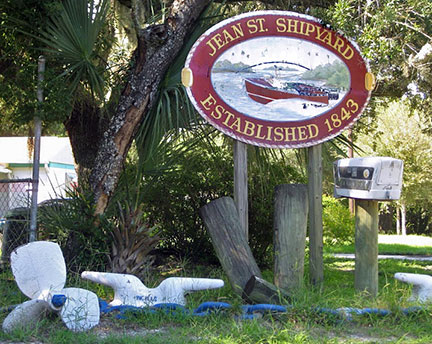
Image
from Jean St. Shipyard website
The Jean Street Shipyard (est. 1843) is a shipyard located on the
Hillsborough River in Tampa. It is located approximately 5 miles
from the mouth of the Hillsborough River, about 1 mile above the
Hillsborough Avenue bridge in what is now the neighborhood of
Seminole Heights. It is a full service shipyard with wet slips and
a Travelift for hauling vessels from the water.
The shipyard was first established in 1843, as
far upriver as was navigable on good solid ground. This allowed
the shipyard to be surrounded by good quality shipbuilding
material, as well as protect it from storms and weather. A massive
wharf was built for the loading of local cargo, but the primary
function of the shipyard was servicing and repairing riverboats,
skiffs, barges, and local sloops. The site was equipped with a
machine shop, wood shop, a marine hardware store, and railways for
hauling vessels from the water. James McKay, a schooner captain,
was one of the first owners of the shipyard and used the
facilities to maintain his cargo and trading vessels, including
steamships, schooners, sloops, skiffs, and barges. McKay was
heavily invested in Tampa, owning a general store and a sawmill.
He also owned two schooners that he used in the cargo trade with
Cuba, Central America, and South America. McKay was elected mayor
of Tampa in 1859. |
| |
|
|
1861 - Magbee begins a campaign against McKay
John T. Lesley
was a prominent cattleman and like many of the prominent men
in Southern communities at the onset of the Civil War formed
a military company at his own expense. Lesley’s Tampa troops
who were later described as coming from “the best families
of the town and vicinity,” trained and paraded through Tampa
streets while waiting two months to be sworn in.
Unfortunately, some
of the Lesley’s youngsters were more used to parties than digging
the earth works ordered by Col. William I. Turner, commander of
Fort Brooke and a veteran of the Second Seminole War. This lack of
discipline led to problems.
In one instance
in April 1861, Lesley and his men refused to obey the direct orders of Turner, a
colonel in the state militia. They had seized and refused to
return a fishing smack belonging to the controversial James McKay
whose business dealings, including selling Florida beef and
supplies to Unionists in Key West since 1858, placed his loyalty
to the Confederacy in question. The high jinks by Lesley’s men
angered fellow merchant, John Darling and others who wanted the
men placed under Turner’s authority.
Tampa’s citizens
informed Governor Madison Perry
of the conflict at Fort Brooke and Turner’s strict conformity to
orders
in a letter dated June 27, 1861. McKay wrote and asked the governor to clarify for Lesley
and his men that they were subject to his friend, Turner’s
authority.
When McKay headed to
Tallahassee to speak to the governor in person, Magbee began a
campaign in the Peninsular to have McKay arrested for petty
treason.
Magbee
responded to McKay in a letter to the Florida Peninsular, July 19,
1861. After comparing McKay to Benedict Arnold, Magbee wrote:
"Former differences I
burn upon the altar of my country and will to the last moment
stand side by side with any one in the cause of the South. She
is now entered into a Just and Holy war, in which every man,
woman and child is and should feel interested and we have not
the right to cater to the views and interests of friend or foe,
whose conduct cannot meet the smiles and plaudits of our
country, the land of the "stars and bars," the home of the
patriot where the only temple of true fealty has been preserved.
I am a Southern man by birth, was reared and educated in
Georgia, was born a slave owner and have owned slaves all my
life and am also an undoubted secessionist."
Gov. Perry agreed
with McKay, but Lesley's unit was mustered out before McKay’s boat
was returned. Col. Turner was replaced in late July by Florida
Militia General, Joseph M. Taylor.
The Robles Family During the Civil War in Tampa, by Karen
Lucibello |
|
Upon his
arrival back in Tampa, McKay was arrested and charged with petty
treason against the State of Florida.
|
1861 - Sen. Magbee is prosecutor in controversial James McKay
trial
On
August 10, 1861, Magbee once again entered the political
arena in the highly controversial McKay treason case.
Court was not in session at the time, so McKay’s trial was held
before two justices of the peace at the Hillsborough County
courthouse on August 10. McKay was represented by James Gettis and Ossian B. Hart. The
volunteer prosecutor was none other than Senator James T. Magbee.
|
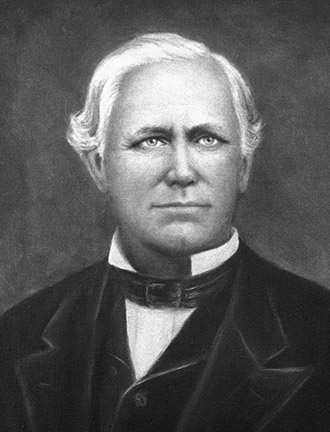 |
|
Ossian B. Hart
10th Governor of Florida, and first governor of Florida who
was born in the state.
Wikipedia |
McKay
believed that "the whole matter originated through malice of two
or three dishonest Govt. officials, who, a few years before, I was
instrumental in having removed from office for their bad acts" [referring
to Magbee.]
Cattlemen associates of McKay’s offered, in his words, “to come in
mass and break up the justice court,” but the defendant declined
their efforts.
McKay's defense was
ably conducted by Tampa lawyer and future Republican Governor Ossian Bingley Hart,
a Tampa Unionist,** and James Gettis, McKay’s personal lawyer and a
northern-born secessionist. Also, McKay’s friend, militia
Brigadier General Joseph M. Taylor, as a local man put it, “sat
himself on the trial."
**In
the United States, Southern Unionists were white citizens living in
the Confederate States of America, opposed to secession, and
against the Civil War. These people are also referred to as
Southern Loyalists, Union Loyalists and Lincoln Loyalists.
James McKay's
trial is continued after the Gettis profile below
1861 - Sen. Magbee is prosecutor in controversial James McKay
trial (continued)
At
McKay's trial, which was described as "long and acrimonious,"
Magbee
prosecuted the case with vigor and
called for the death penalty, demanding that McKay be
hanged. However, the Justices of the Peace, after the intercession of Gen.
Joseph M. Taylor, commander at Fort Brooke,
Ossian Hart, Gettis,
and a number of cattlemen who pressed the justices to set McKay
free on bail,
avoided judgment
by binding the captain over for a new trial at the October term of
the circuit court. Taylor also arranged
for McKay to pass the new Union blockade and head for Key West.
McKay was required to post a bond of $10,000. Soon after, McKay was allowed to leave Tampa and resume his
business activities. He fled to Key West.
In mid-August Taylor
left Fort Brooke and J. T. Lesley began his short stint as commander
there. In less than two weeks he and his men were transferred to
Shaw Point on the south side of the Manatee River. His unit came
under the new commander of Fort Brooke, Major Wylde Bowen from
Lake City who brought his two companies of the 4 Florida Infantry
formerly of the Cedar Keys.
|
James McKay blockade-running and capture
On October
13, 1861, McKay, who had gone to Key West after his trial
in Tampa, was traveling with his son and crew from
Havana aboard his steamer Salvor when he was captured by the USS Keystone State. A
search of the Salvor reportedly found 600 pistols and rifles, 500,000
percussion caps, coffee, cigars and clothing.
They were brought into Key West where McKay, his son
Donald,
and his crew became prisoners of war and his steamer
was confiscated.
McKay felt
that his ship, the Salvor, which was sailing under the
British flag as the MS Perry, was wrongfully seized by the
Union, claiming he had sold it to a British subject in
Havana.
The Salvor
and its cargo, along with McKay's young son Donald, the
crew, and McKay's slaves, were towed to Philadelphia, while
McKay, and two passengers were detained at Fort Taylor in
Key West. From Philadelphia, Donald McKay and the crew were sent to
prison at Fort Lafayette off the coast of the Bronx in New
York, where they were eventually released on different dates
for various reasons.
It was only after
five months, at a
considerable cost and through the personal intervention
of President Lincoln, that James McKay was allowed to take an oath of allegiance
and was paroled.
See details
of these events in the next section.
On April 21, 1862,
McKay
was back in Key West and returned to Tampa in mid-May. He obtained a
new side-wheel steamer, the Scottish Chief.
Part of the
condition of McKay’s pardon was a promise not to return to
the service of the Confederate cause, a promise the now
bitter McKay abandoned immediately upon his return to Tampa.
Upon his return he
armed the Scottish Chief with a 6- pounder cannon, and went to work eliminating a fleet of
small boats which were fishing with "illegal fishing
contracts" along the lower west coast of Florida and were actually also spying. This fleet of small boats was
supplying Federally-controlled Key West not only with Florida
fish, but also with information about Confederate ships and their positions to the Union army
based at Key West. The Scottish Chief captured 24 small
boats and their crews, thus making Florida waters safer,
but earning a vendetta against him from the Union.
This
vendetta would eventually cost him dearly. Later, according to
Union records, it was the destruction of McKay's two vessels, and
nothing more, that was the actual focus of a attack against Tampa
in October 1862, dubbed the
Hillsborough River Raid.
The Hillsborough River Raid turned into the Battle of
Ballast Point.
After the capture of these “illegal fishing boats” for the Confederacy,
McKay continued blockade running with his sailing sloop, the
Kate Dale, and his prize vessel, the
Scottish Chief. He made six more successful runs past Union
vessels with Scottish Chief.
At first
he carried beef to Havana but as beef became more vital to the Confederacy
and the Florida legislature outlawed the export of cattle, he
shifted to cotton. For the relief of the remaining Tampans he also
brought in medicines, rum, foodstuffs and other supplies.
The relief offered to
Tampa by McKay and the other local blockade runners so rankled
Union blockaders that on several occasions Union ships entered
Tampa Bay to reek mischief and remind Tampa citizens that they
were being blockaded.
By October
1863, McKay was ready to make another run with bales of
cotton through the blockade with the Scottish Chief and
his new vessel Kate Dale, a small sailing sloop. Neither
ship drew more than 4 feet of water.
Congressional Edition, Volume 3788
Hillsborough River Raid.
The Hillsborough River Raid and Battle of Ballast Point
|
|
|
|
Tampa furnished several companies of men for the army, and
after a year, the inhabitants, all of whom could leave,
moved to the country and the town again began going down
grade. Some few troops were kept as a guard to give notice
of the approach of the enemy -- not for protection of the
place, for this they could not do. Tampa was a dead town at
this time. Only when the enemy gunboats visited the place
and would throw a few shots and shells in the town did the
people show much life.
by James
McKay, Jr. in "Reminiscences
- History of Tampa in the Olden Days" Dec. 18,
1923
|
|
1862 - McKay exonerated
When the Grand jury met at Tampa during the fall of 1862, James
McKay was exonerated from his treason charge prosecuted by Magbee the previous year.
The presentment stated that “the prosecution was instigated by
private malice or some not more laudable motive." McKay’s ally,
Gen. Joseph Taylor, was acting solicitor during the proceedings and
Madison Post was foreman of the grand jury.
The deck was stacked
in favor of McKay.
|
After the war,
the two vessels that carried these troops to Tampa, named
Honduras and Huzzas, both were purchased by my father and
renamed the Governor Marvin, and Southern Star. Many
times have I read the log books of these vessels giving an
account of this expedition. Captain Van Sice commanded the
Honduras at the time of this expedition. I got acquainted
with him in Havana after the war, he then being master of
the City of Vera Cruz of the Alexander Steamship Line plying
between New York and Havana. He discussed with me the
capture of Tampa. A few years later Captain Van Sice,
with the City of Vera Cruz, was lost in a hurricane off St.
Augustine.
by James
McKay, Jr. in "Reminiscences
- History of Tampa in the Olden Days" Dec. 18,
1923
The
Steamship Governor Marvin, of which I was master, was owned
by my father. She was originally built to carry cattle from
Honduras to Cuba just at the beginning of the war, but was
taken by the United States Government and was named
Honduras; At that time she was chartered by the United
States Government and was used as a transport flying along
the Florida coast from New Orleans to Key West and the
Tortugas. When my father purchased her he changed her name
to Governor Marvin. My father purchased her in New
York after the War in 1865, and I lost her in the hurricane
of 1872, but got her into the harbor of Key West before she
sank. She was named after the Provisional Governor of
Florida who was and had been a true friend of my father long
before the Civil War. --James McKay, Jr
|
|
After the close of the war we all returned to our homes,
which we found in most instances in a dilapidated condition.
Tampa was a hard-looking place. Houses were in bad order.
Streets and lots were grown up mostly with weeds and the
outlook certainly was not very encouraging. To make matters
worse two companies of negro soldiers were sent to garrison
the place. White officers commanded them. It was not long
before the troops became overbearing and in some instances
threatened arrests of our citizens.
I was one that was to be brought before a military court,
for the destruction of papers and documents. Getting uneasy
over the many reports coming in, I with my brother Donald,
mounted our horses and laid out in the woods for six weeks.
The excited condition of the country and activity of the
officers at this place being reported to Washington by a
revenue officer, a special agent was sent here to
investigate with authority to act and he soon had matters
straightened out.
I received notice from my father to report to the commanding
officer in the garrison before stopping anywhere, which I
did and was given a paper stating that I was not to be
molested only on order from Washington. Shortly after this
event the negro soldiers were removed and white troops of
the regular army went to garrison the place. It was not long
before they were on good terms with the citizens - and
assisted in pushing the town ahead, trying to make us forget
that we were enemies at one time.
by James
McKay, Jr. in "Reminiscences
- History of Tampa in the Olden Days" Dec. 18,
1923
|
|
My father succeeded in getting to Havana by a fishing smack
and from his friends in Cuba got sufficient funds to take
him to New York, landing there with only a few dollars in
his pocket. Meeting the old merchants he dealt with previous
to the war, they assisted him in buying the Steamer
Honduras, which he named the Governor Marvin, costing
$72,000.
He also bought a stock of goods valued at $24,000. He left
New York in October, 1865, with this vessel loaded and 165
passengers. He met a hurricane off St. Augustine and came
very near losing vessel and all hands, but by the
graciousness of the Heavenly Father he pulled through it
with some slight losses only.
Two or three days after the hurricane, in passing down along
the Florida reef, he saw some 21 vessels of all kinds
ashore, as quick as he could, he discharged freight and
passengers that were for Key West, patched the steamer up,
and left for a bark loaded with sugar and a steamer that was
ashore and worked on them for two weeks, for which he
received enough to pay for one-half of the Marvin.
When reaching Tampa about the last of November, he entered
into the shipping of cattle to Cuba but as the cattle were
beginning to get poor and the grass being bad in Cuba, they
did not sell for sufficient to pay for cost, duties, and
freight and about the last of December he discontinued
shipping them. In the meantime stores opened on Washington
street and although there was not much money in circulation,
still there was considerable business, mostly in trade. I K.
Roberts and Company operated a weekly line of steamers along
the coast from New Orleans to Havana, bringing freight and
passengers. That was of great assistance to this section of
south Florida
by James
McKay, Jr. in "Reminiscences
- History of Tampa in the Olden Days" Dec. 18,
1923
|
|
In 1866, during
the summer, the trade with Cuba had increased to such an
extent that my father purchased the Steamship Southern Star
to assist the Governor Martin to freight cattle, but the
demand did not last longer than that year, as the
insurrection in Cuba broke out and buyers were afraid to put
cattle on pastures. He chartered the Marvin to a party of
Spaniards to load mules at Tampico, but when we arrived
there found an insurrection had sprung up in Tamaulipas and
we were detained for a month, when we loaded 357 mules for
Havana. Arriving at our destination we found the city in a
state of excitement for fear of an attack from the Cuban
army. The night of the day of our arrival, while myself and
officers of the ship were upstairs in the Louvre playing
billiards, as a battalion of Spanish soldiers were passing,
someone fired a pistol. The soldiers opened fire on the
lower or ground floor and shot the place all to pieces. We
made our escape over the tops of buildings and were let down
through a trap door on the top of the building on the
opposite side of the block. It was not long before we found
ourselves on board the Marvin and very glad to be there.
by James
McKay, Jr. in "Reminiscences
- History of Tampa in the Olden Days" Dec. 18,
1923
|
|
A renegade judge of the court was placed in office in
this section and with the notorious Jim Green and his
deserters to assist him, they joined the republican party,
the fight became quite interesting. The loyal Confederates
soon were engaged in a struggle that was not much inferior
to the war between the states. At one time it appeared as
another losing proposition but with the aid of the Ku Klux
Klan, all over the south began to see daylight.
In 1876 this state as well as others, emerged from the fight
by placing George E Drew in the governor’s chair, [but]
Florida’s vote was given to Hayes. It was not long after
this when the renegades and deserters were fired from office
and sound democrats installed. From that time this section
began to improve, and every person felt safe and happy.
Previous to this there were many night rides by the
citizens, to accomplish what they did.
by James
McKay, Jr. in "Reminiscences
- History of Tampa in the Olden Days" Dec. 18,
1923
|
|
I have been compelled to mention my father many times, which
I could not prevent, from the fact that in the early days of
Tampa there was not a single interest connected with the
town but what he was either the originator, or connected
with it in some manner. He was identified with every
improvement in the town.
As this article is rather lengthy I will close, wishing you
and all a merry Christmas and a happy New Year..
by James
McKay, Jr. in "Reminiscences
- History of Tampa in the Olden Days" Dec. 18,
1923
H. B. Plant's
steamer Olivette was a 250-foot ship built under the
supervision of Capt. James McKay, Jr. in Philadelphia and
launched February 16, 1887. Captain McKay brought the vessel
in April 29, 1887 [to Tampa] and thereafter served as her
master.
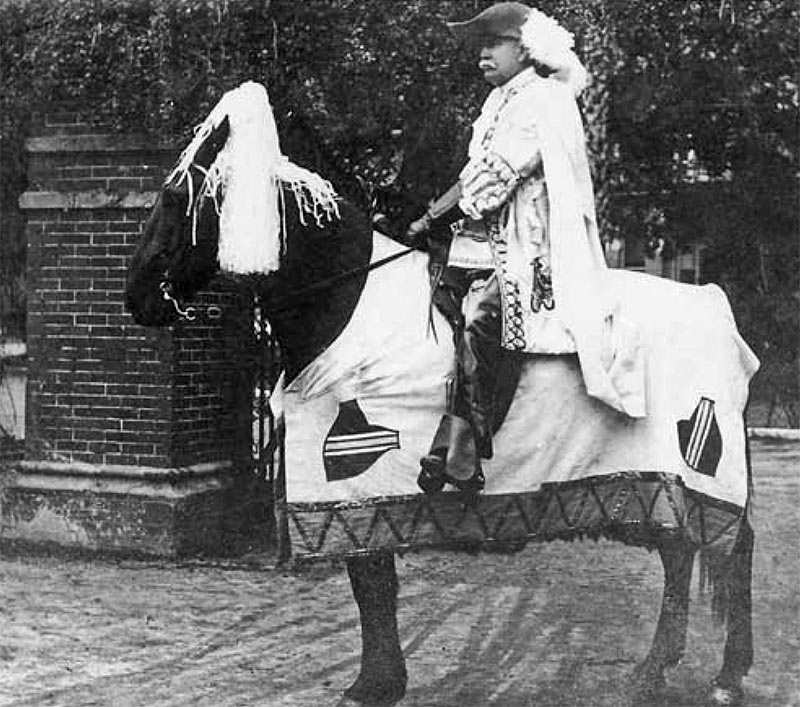
James McKay Jr. on his horse during
the 2nd Gasparilla invasion, 1905.
Photo from the Lesley Collection, Tampa Bay History
Center.
|
|
|
TRIBUTE TO JAMES MCKAY, SR. AT TAMPA'S RIVERWALK

Photos and info below are from the Historical Monument Trail
website, Friends of the Riverwalk.
|
|
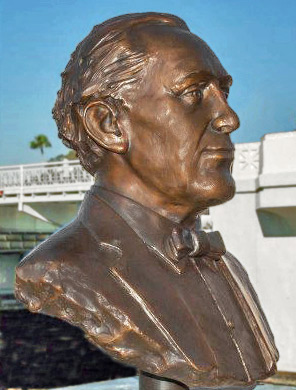
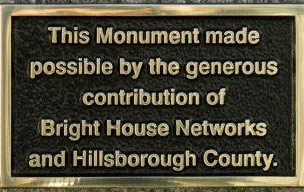 |
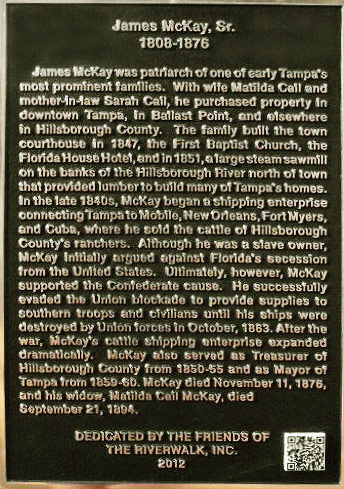 |
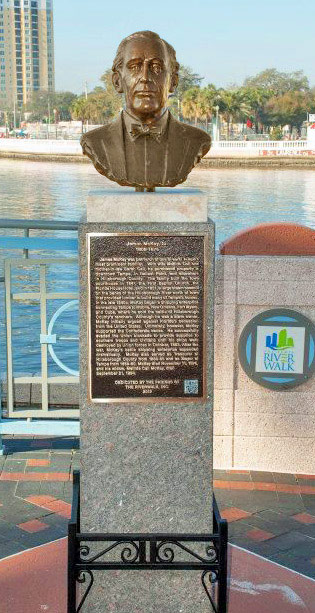 |
|
James McKay was born in northern Scotland 1808. As a
young man, he took a liking to the sea and became a master mariner. McKay
moved to the United States where he married Matilda Cail, who was born in
Edinburgh, Scotland. In 1846, James and Matilda, along with her mother,
Sarah, moved to Tampa. McKay purchased property downtown as well as in the
Ballast Point vicinity and elsewhere in Hillsborough County. |
|
He built a downtown courthouse in
1847, the First Baptist Church, the Florida House Hotel, and in 1851, a
large steam sawmill on the banks of the Hillsborough River north of town
that provided lumber to build many of Tampa’s homes. Shortly after
the severe 1848 hurricane, McKay began a shipping enterprise connecting
Tampa to Mobile, New Orleans, Fort Myers and ultimately Cuba, where he
sold the cattle of Hillsborough County’s ranchers.
Although he was a slave owner, McKay
initially argued against those who called for Florida to join the
Confederate secession from the United States. Ultimately, however, McKay
supported the Confederate cause. He successfully evaded the Union blockade
to provide supplies to southern troops and civilians, until his ship was
destroyed by Union forces in October 1863. After the war, McKay’s cattle
shipping enterprise expanded dramatically. He also briefly served on the
county commission in 1870, adding to his earlier periods in public office
as mayor of Tampa in 1859-60, and as the treasurer of Hillsborough County
in 1850. McKay died November 11, 1876, and his widow, Matilda Cail McKay,
died September 21, 1894. |
|
TAMPA WATERWORKS
CO.
vs.
GEORGE W. CLINE
This Supreme Court case reveals general information about the
ownership of the Magbee Spring area, and the hydrology of the
spring itself.
According to "Cases
Adjudicated in the Florida Supreme Court, Jan. term, 1896,
in a previous State Court case,
Tampa Waterworks Co. v. George W. Cline, concerning
the land formerly belonging to James T. Magbee where the
waterworks spring was located, complainant Tampa Waterworks
Co. sought an injunction against George W. Cline Sr. and Jr. Apparently,
the Clines were
excavating on their property, and among other allegations of
malicious intent, planned to build a bathing
pool. Tampa Waterworks claimed this would interfere with
the flow of the spring and was polluting the water used in
supplying the city.
The State Court
case was originally filed against George W. Cline Sr. and Jr,
but then was amended later to include only Sr. upon the death of
Jr.
The Tampa
Waterworks Co. (hereinafter "TWC") was in contract for 30 years
with the City of Tampa to furnish an abundant supply clean
water for the purpose of drinking. To accomplish this,
the corporation acquired title in fee to Lots 6 and 7 in Block
28 [sic] (should
be Block 23, there is no Block 28)
in the first addition to Highland Park, in the South half
of Lot 1, Sec. 13, Towship 29 South, Range 18 East, according
to a Brown and Swingley plan and map used as an exhibit:
The lots were
originally a part of a much larger tract of land owned by
James T. Magbee, deceased, and that his heirs and distributees
laid off the tract into lots and blocks, with streets and
alleys, all within
the corporate limits of the City of Tampa. That Lot 6
has issuing from underneath the ground thereon natural
spring of water which is supplied by a well-marked and
defined subterranean
stream coming from the east, and flowing underneath the ground
at a depth of 12 or 15 feet below the surface of land
of both defendant Cline and complainant Tampa Waterworks
Co.,
until it issues out of and forms the spring in Lot 6, where it
again disappears beneath the surface, but comes out again a
few feet from the western boundary of complainant's land and
flows thence in a stream in a westerly course to the
Hillsborough River, some 200 feet away.
TWC and those who
have owned this land for at least 17 years prior, highly
prized the water for its purity, and if maintained in its
present state would continue to be useful in its obligation to
supply the city with water.
Complainant TWC
alleged that George Cline Sr, with the intention to harass and
injure TWC, had recently acquired title to lots 1, 8, 9 & 10,
in block 23, immediately above TWC's land, and was proceeding
to excavate, and had excavated, a large and deep hole on his
lot 8, near the TWC's lot 7, which was around 18 to 20 feet in
circumference, and some 12 to 14 feet deep, which penetrated
to the water of the subterranean stream.
In the diagram below, the 1888 First Addition to Highland
Park with the Magbee Spring has been overlaid onto a present
day plat of Block 23 and 24, Tampa Waterworks Co. Lots 6 & 7 are
marked in green, Cline's Lots 1, 8-10 marked in red.
Location of Cline's excavation is approximated with X in
blue dot. The wavy blue arrow marks the general flow
direction of the underground stream as Tampa Waterworks
contends.
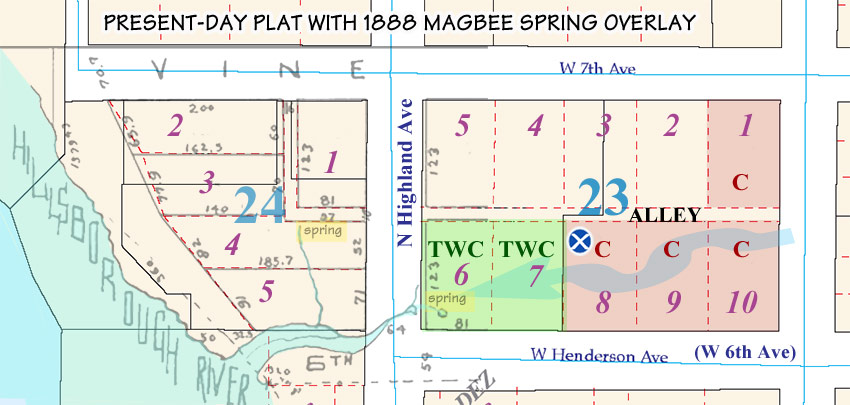
TWC charged that
in making the hole, Cline acted wantonly and maliciously, for
the purpose of injuring TWC by polluting the water flowing
into the spring, and diminishing the flow, which would happen
if the continued to be dug or was permitted to remain.
TWC further
charged that Cline intended to put up a bathing pool or pools
where the hole was, and would if not restrained, use it to
pollute and diminish the flow of water, with the view to
damage the TWC, or compel it to purchase that land at an
exorbitant price.
Mention is made
that TWC expended large sums of money previously drilling a
well somewhere else, but failed to secure a large enough water
flow sufficient to supply the city. (This well would
have been #1 at 6th Ave. & Jefferson St.)
TWC further
contended that the Magbee spring was the only one with enough
water to supply the city economically, and if Cline was
allowed to continue, the water would become polluted and
totally worthless. That the water runs under and between
a rock formation, the top of which is some 6 feet below the
surface, and extends down until the subterranean stream is
reached, and without the excavation being made, it is not
possible to pollute the water until it comes out on TWC's
land, at which time they could thoroughly protect it when its
waterworks was built.
TWC asked for an
injunction, if even only a temporary one, stopping Cline from
further digging and making him fill up the hole.
Cline's answer
was that the south half of Section 13, of TS20S, R18E,
belonged for many years to Magbee who conveyed 7 acres of it
in 1885 to Cline's wife. That Magbee died still owning
the remainder of the lot, which had recently been laid off
into lots, blocks and streets, and that W.A. Jeter and G.A.
Boardman purchased by mesne conveyances* from a distributee of
the Magbee estate (which would have been Magbee's sister, or
brother, or maybe even widow) Lots 6 & 7 of block 23, and
afterwards sold them to TWC. Then in July, 1889,
defendant Cline purchased from the distributees of Magbee's
estate, lots 1, 8, 9 and 10 in block 23, for the purpose of
improving and beautifying the lots and developing their own
water supply. That soon afterwards, began to excavate a sink
on lot 8, at a point about 20 feet from the alley, and a few
feet east of TWC's lot 7, and after removing a large amount of
marl** and decayed vegetable matter, came upon a large spring
of pure cold water of great use and value to Cline and the
estate which he had purchased. He also developed a large
bed of marl of great value as a fertilizer and for paving
roadways and sidewalks, and hoped would yield him great profit
in helping to defray the expense of cleaning out and
beautifying the spring.
*
Mesne conveyance - An intermediate conveyance; one
occupying an intermediate position in a chain of title
between the first grantee and the present holder.
**Marl -
An unconsolidated sedimentary
rock or soil consisting of clay and lime, formerly used
typically as fertilizer.
Furthermore,
Cline stated that the land to the west of the excavation he
was making to improve the spring falls rapidly to the street
over 2 lots of the TWC's land, so that when the sand and marl
are removed and the excavation enlarged to open up the sink to
its natural edge, no rain falling around the excavation can
run into TWC's property. That the level of the water in
Cline's spring is 13 feet below the surface of the surrounding
land, and about 4 feet above the water level in the ground, so
that the surface water can not come into the spring fully
saturated with water, which can only occur in case of unusual
flood, and then the water would come by percolation through
the sand and marl into the spring, but at no greater extent
than if the excavation had not been made. That the sand
of the countryside was coarse, the topsoil spongy, and the
underground drainage so complete that no water ever seen on
the surface.
Cline's answer
denied that the spring comes out of the ground on TWC's land,
and denies that he has polluted, or intends to pollute, the
water in the stream. He denied that he intended to
divert the spring from its natural channel, or that the rays
of the sun, and the surface drainage by reason of the
excavation, will pollute the spring. He also denied that
he purchased the lots with intent to harass and injure TWC, or
that the excavation was made maliciously for the purpose of
compelling TWC to purchase the lots, and the allegations of
the intent of Cline to put bathing houses in the water and
thereby pollute it, were denied.
Cline said that
the excavation was made in good faith for the purpose of
enhancing the value of his own lots, and to lawfully use the
water, and that his spring is not supplied by a subterranean
stream with a well-defined channel, but by water coming from
unknown and undefined sources, and that the water comes from a
great depth and from unknown percolations.
Cline then filed
a motion to dissolve the injunction, a upon the preliminary
hearing there was a modification of the injunction granted, to
the extent of allowing Cline to dig to the stream and take a
reasonable quantity of water as might be necessary for his
use, but not to take or divert the water wantonly, or to
transport it to another place. The modification also
permitted Cline to quarry any stone he might desire, provided
that he did not pollute or injure the water flowing into TWC's
spring.
Testimony was
then taken, and upon final hearing the bill was dismissed and
TWC appealed.
What follows in
the Supreme Court case are the opinions of that court and the
precedents on which it ruled. In those opinions, the
Court considers much information pertaining to geology of
springs and rights to them, and makes these comments:
The tract of land
through which the water in question runs belonged for many
years to James T. Magbee, and after his death, some time
during the year 1888, his heirs and distributees had it
platted into lots, blocks and streets, which are now within
the corporate limits of the city of Tampa. Appellant (TWC),
through mesne conveyances, acquired title to Lots 6 & 7 of the
plat in the early part of 1889, and a few months later
appellee (Cline) purchased Lots 1, 8, 9 and 10, which were
immediately east or northeast of TWC's lots. The
formation of the land 12 to 15 feet below the surface, and in
which water is found, is of a limestone character.
There is some
diversity of opinion among the witnesses as to the character
of the rock in contact with the water. One of TWC's
witnesses, an expert, states that the rock in contact with the
water was stratified (layered), and away from it was in
boulders lying in detached lumps. Considering all the
evidence there is no doubt that the land is underlaid with
rock of a limestone formation. Issuing from the Magbee
tract of land not far from the Hillsborough River was a bold
spring of constantly flowing water, known as "Magbee Spring,"
and the plat located this spring in a street or avenue.
The lots purchased by TWC were east and northeast and nearest
to the spring. From the spring east and northeast across
the lots of both parties there were surface depressions or
sinks, such as mark the course of subterranean streams in
limestone regions. On one of TWC's lots a sink went down
so that the water below could be seen, and at or near this
point the company's waterworks for supplying the city with
water were established. A deep shaft was dug (by Cline)
and a reservoir made to receive the water running in an
underground stream, and it is an alleged diversion and
disturbance of this water supply that caused the company to
complain. Appellant (TWC) commenced to excavate first
(referring to TWC's first attempt for #1 at 6th Ave &
Jefferson St.) but then changed locations. Before (TWC's)
2nd excavation for the reservoir (at Magbee) was commenced,
Cline began an excavation in a sink on one of his lots a short
distance away, and had reached a stream of running water when
the injunction was served on him. From the evidence in
the record we are satisfied that the stream reached by Cline
in his excavation extends to the reservoir of TWC. The
source of this steam is left in speculation, without definite
proof, but from all that is shown we are of the opinion that
this is a well-defined subterranean stream flowing through the
lands of both parties.
There is some
diversity of opinion among the expert witnesses examined by
TWC as to the course and limits of the stream. From
Magbee Spring, where the stream issues from the ground, to the
river, the banks are 20 or more feet wide, and one expert
states that the stream above covers an equal space in circuit;
while another was of the opinion that it covered a much larger
space, and was probably supplied by several lateral streams
converging at the point where the reservoir of TWC was
located. The depressions and surface indications in a
direct line over the lands of the parties, and for some
distance further east, indicate a sub-surface stream as found
in limestone formations. The capacity of this stream at
the reservoir, not more than 175 feet from Cline's excavation,
is between 2 and 2 1/2 millions of gallons of water per
day, and fresh water fish from 6 to 10 inches long were
discovered in both excavations. The water when muddied
or colored with analine dyes in Cline's shaft showed in a
very short time in the one below, and from such evidence of
a well-defined stream taken in connection with that of the
experts we do not doubt that it does exist. The rule
as to well-defined surface streams must therefore be applied
to the stream in question. Cline has the right to the
use of this water as much as if it ran upon the surface of
the ground. He cannot divert or pollute it, but he may
open up a water supply on his own land so as not to
interfere with the legal rights of adjoining owners, and
also make a reasonable application of the water, certainly
for domestic purposes. We discover no reasonable
objection to the improvement of his own property by the
removal of the soil in the depression between the rocks,
over the stream and beautifying the place by opening an
accessible way to the water. The mere opening of a
space so that the rays of the sun can reach the water below
will not of itself be a contamination or an unreasonable use
of it. It is true that impurities from surface
drainage might get into the stream if unprotected and
thereby pollute it, but this cn be guarded against; and it
is the duty of Cline to prevent the surface water from
overflowing into the opening made by him. There is no
sufficient showing that any serious injury has been done, or
will be done with proper precaution, to the stream by reason
of the opening. The maxim, sic utere tuo ut non
alienum laedas* will apply.
*The maxim sic utere tuo ut alienum non laedas does not mean that one must
never use his own property in such a way as to do any injury
to his neighbor. It means only that one must use his
property so as not to injure the lawful rights of another.
Under this maxim, it is well settled that a property owner
may put his own property to any reasonable and lawful use,
so long as he does not thereby deprive the adjoining
landowner of any right of enjoyment of his property which is
recognized and protected by law, and so long as his use is
not such a one as the law will pronounce a nuisance.”[
Fontainebleau Hotel Corp. v. Forty-Five Twenty-Five,
Inc.,114 So. 2d 357 (Fla. Dist. Ct. App. 3d Dist. 1959)]
We do not see
that we can hold, on the showing made, that Cline has
diverted the water in the stream. According to the
testimony of witness Campbell...(two opposing witness
opinions presented.)
We do not think
the testimony shows that Cline acted wantonly and
maliciously...
We are further
satisfied that it is not sufficiently shown that Cline
intended to devote his excavation to bathing purposes...
If it is not
affirmatively shown that the subsurface water is supplied by
a definite flowing stream, the presumption is that it comes
from ordinary percolations. The testimony is also
indefinite as to the character of the blasting done or
contemplated by Cline, and our conclusion is that the decree
(of the lower court) should be affirmed on the evidence.
While Cline has
the right to use the stream in the manner indicated, and may
also make such legitimate use of his own property as he
pleases, he must do so in a manner not to divert or pollute
the stream of water flowing through it.
On the
allegations of the bill and the evidence submitted, the
decree will be affirmed, and it is so ordered.
George W Cline Jr
gravesite
|
|
About Archie Donnelly
Magbee, James & Julia's adopted son
From an archived genealogy post of Feb. 27, 2004 at RootsWeb, by
Clare
I first heard his
name from Mace Magbee of Whittier Ca. in 1994, wanting to know if
I had James T. Magbee in my data base. I did not but did a little
research for him. Mace has a brother Byron "Jr." whom I also
corresponded with and he gave me information on their family, but
nothing on James T.
Here is what I found
then: James T. Magbee b. c. 1820 in Ga d. Tampa FL, was
married to a woman named Julia. He and Julia adopted a boy named
Archie Donnelly who immigrated from Edinburg, Scotland.
Archibald Donnelly (he changed his name to Magbee) married Fanny
Pinkard in Atlanta c. 1890 and had 4 children, Ruth, Francis,
Byron "Sr." and Kathryn.
Mace and Byron are
the sons of Archibald and Fanny's son Byron "Sr." who died in
Columbus, OH. According to Byron "Jr." Magbee, the grandson,
Archibald and his brother Lucius**
were brought to this country by
their parents about 1860, the parents died during the voyage and
the two young boys were orphans landing in Key West. They were
adopted by Judge Magbee.
**TampaPix note: There is no record of a brother to
Archie Donnelly in the home of James T. Magbee, nor does any
historian mention Lucius. Lucius was Archie's brother-in-law, born
in Alabama, brother of Archie's wife Frances Pinkard. See
link for 1910 Census of Archie Magbee above. Archie
immigrated to the U.S. in 1867 according to his 1910 census in
Clinton, Franklin Co., Ohio.
Apparently Lucius
went to Tulsa, OK (I know there are Magbee's in OK but don't know
if they are the descendants of Lucius Donnelly (or Magbee?)
Archibald, also was in the newspaper employ in Atlanta and worked
last being at The Miami Herald where he died in 1951 in Miami .
James T. Magbee had
no children of his own. I was able to find nothing more on James
T. Magbee at that time so just filed it away in my "great file" of
unknowns. Now to the present!
In January I was
working in the University of South Florida Library, in Tampa, ask
to have some copies made of material I had found on my husband's
Simmons line, and had to give them my name. The very nice
Librarian ask me if I was related to Judge James T. Magbee, a very
well known person in Tampa in the 1880s. I said no but I knew of
him. He printed me out pages and pages about this man and this is
what the print out said...
...He was married 3
times, Susan Adaline (Almeria?) Tatum, 2. Julia and 3. Carrie Burr Fisher.
James T. was born c. 1820 in Butts Co., GA and died in Tampa 12
Dec 1885, the son of Hiram Magbee and Susannah Wooten. Hiram was
the son of James Magbee and Rachel Buckley. His older brother was
Laban Magbee who married Rebecca Whatley in Greene Co., GA in
1806. Laban is my husbands ancestor. If you would like more on
this James T. Magbee I would be happy to copy the information and
send it to you but this is basically all the genealogical
information on him.
The rest is about his
antics and career, his burial, (if I remember correctly he gave
the land for the city cem. in Tampa). Hope this sparks some
interest in this line. I believe that James Magbee who was married
to Rachel Buckley was the son of James Magbee and wife Sara (they
died in Franklin Co., GA , both James Magbees died about the same
time. I have not been able to prove that James and Sarah were the
parents of James married to Rachel. Surely would like help there.
I also know of any other children of Hiram and Susannah Wooten.
Hiram was not of age when his father died and Laban, his brother
was named his guardian. --Clare
This feature
relies heavily on
this excellent biography of James T. Magbee by the late
Kyle S. VanLandingham, a direct descendant of William B.
Hooker. It appeared in the Nov. 1994 Sunland
Tribune, Journal of the Tampa Historical Society.
TampaPix believes it is the best-researched and most
accurate portrayal of the life of James T. Magbee.
JAMES T. MAGBEE: “Union Man, Undoubted Secessionist, and
High Priest in the Radical Synagogue” By Kyle S.
VanLandingham, at the USF Digital Collections.
 VANLANDINGHAM,
Kyle Samuel, 57, who was a historian and genealogist, died
November 17, 2009, in a Denver hospital from the H1N1
virus, also known as swine flu. He is survived by his
mother, Jane Ernestine Alderman VanLandingham; and
brother, Larue Pierre VanLandingham and wife, Denise, of
DeFuniak Springs, Fla. He was preceded in death by his
father, Samuel Pierre VanLandingham. VANLANDINGHAM,
Kyle Samuel, 57, who was a historian and genealogist, died
November 17, 2009, in a Denver hospital from the H1N1
virus, also known as swine flu. He is survived by his
mother, Jane Ernestine Alderman VanLandingham; and
brother, Larue Pierre VanLandingham and wife, Denise, of
DeFuniak Springs, Fla. He was preceded in death by his
father, Samuel Pierre VanLandingham.
Mr. VanLandingham was born
December 10, 1951, in Fort Pierce, Fla., where he
graduated from Dan McCarty High School. He subsequently
received a Bachelor of Arts degree from Maryville College
in Maryville, Tenn., and a Juris Doctor degree from the
Cumberland School of Law at Samford University in
Birmingham. After receiving his law degree, Mr.
VanLandingham opened a law office in Okeechobee, Fla., and
shortly thereafter was appointed county attorney for
Okeechobee County in 1978. He held that office for just
short of 10 years, at which time he came into a family
inheritance. Resigning his position as county attorney, he
embarked on what would be his true vocation, researching
and writing about genealogy and Florida history. He also
indulged his love of travel, visiting 26 countries. When
traveling in the United States, he was always on the
lookout for the best local barbecue. His favorite was
Eastern North Carolina BBQ. After leaving Okeechobee, Mr.
VanLandingham lived in Savannah, Riverview, Fla.,
Kerrville, Texas, and Denver, Colo. While in Riverview, he
was active in the Tampa Historical Society, serving as
president for one year, as editor of their publication,
Sunland Tribune, for seven years, and contributing
numerous articles. During this time, he authored the book,
In Pursuit of Justice: Law & Lawyers in Hillsborough
County 1846- 1996. His other books include Florida
Cousins: The Descendants of William H. Willingham, Parker
and Blount in Florida, A History of Okeechobee County,
Pioneer Families of the Kissimmee River Valley and
Pictorial History of Saint Lucie County 1565-1910. Mr.
VanLandingham also served as the president of the St.
Lucie County Historical Society for one year and as a
director of the Florida Historical Society for three
years. Mr VanLandingham was a Mason and served as the
Worshipful Master of Okeechobee Lodge No. 237 Free &
Accepted Masons in 1985. Kyle, who took great pride in
being a sixth-generation Floridian, will be missed by his
family and all his historical and genealogical
collaborators, for whom he was an endless source of
valuable and accurate information.
Published in the Tampa Bay
Times on Dec. 10, 2009
|
| |
|
SOURCES
(For this Magbee feature and the Ulele Springs history feature)
-
Beck Group, Architects, Constructors, website
-
Bureau of
Land Management, Government Land Office records
-
Biographical Directory of the United States Congress, 1774 -
Present
-
Biographical Sketches of Circuit Judges, Florida's 10th Judicial
Circuit - James T. Magbee
-
Blockaders, Refugees, & Contrabands - Civil War on Florida's
Gulf Coast, 1861-1865 by George E. Buker, "Henry Crane -
Unionist"
-
City of Tampa Local Historic Landmarks
-
City of Tampa Parks & Recreation Dept., Oaklawn Cemetery
-
City of Tampa website, Previous Tampa Mayors
-
Civilwaralbum.com, Courthouse Civil War Monument
-
Ecosphere Restoration Institute
-
Exploring Florida, Maps ETC.
-
Exploring Florida, Capt. James McKay, I, historic marker
-
Familysearch.org, census records, marriage records
-
Florida Civil War Blockades: Battling for the Coast By Nick Wynne,
Joe Crankshaw
-
FLORIDA HISTORICAL QUARTERLY, Vol. 70, No. 4, April 1992 -
TAMPA’S JAMES MCKAY AND THE FRUSTRATION OF CONFEDERATE
CATTLE-SUPPLY OPERATIONS IN SOUTH FLORIDA by CANTER BROWN, JR.
-
Florida Memory, State Library & Archives of Florida, Photographs
-
FLORIDA STATE UNIVERSITY LAW REVIEW, Vol. 6, Issue 1, Winter
1978, Frederick B. Karl Marguerite Davis - Impeachment in
Florida
-
Genealogy Trails, Old Guardianships
-
Hillsborough Lodge No. 25, F. & A.M.
-
Historium.com American History blog
-
Internet Archive, THE LIFE OF FERDINAND DE SOTO, DISCOVERER OF
THE MISSISSIPPI (Images)
-
Jean Street Shipyard
-
Journal of Civil War Era, Paradise Lost - Egmont Key
-
KEY WEST: THE OLD AND THE NEW,
by Jefferson Beale Browne, pub. 1912.
-
LaMartin.com, William B. Hooker, Orange Grove Hotel
-
Maps, Etc. Johnson's Florida, 1860 Johnson, A.J., Johnson's
New Illustrated Family Atlas (New York, NY: Johnson and
Browning, 1860)
-
Maps Etc., Asher & Adams, Florida,
1871
-
MEMOIRS OF GEORGIA, VOL 1. By the Southern Historical
Assoc., 1895.
-
National Fish Habitat Partnership
-
None Can Have Richer Memories: Polk County, Florida, 1940-2000.
Brown, Canter, Jr. Published by Tampa, FL: University of Tampa
Press, Polk County Historical Association, (2005). First
Edition. (2005)
-
Naval History and Heritage Command
-
Old Florida Ephemera and Musings - Tampa's Urban Springs
March 2, 2013
-
Old Florida blog - Ulele Spring 2.0 - April 2014 photos of the
spring construction and restoration
-
Ossian Bingley Hart: Florida's Loyalist Reconstruction Governor
By Special Assistant and Counsel to the President Canter Brown,
Jr, 1997
-
Pioneer Florida, Volume 2, Chapter 10, "A Self-Made
Scalawag" by Donald Brenham McKay Southern Publishing
Company, 1959
-
Scholar Commons, University of South Florida, SUNLAND
TRIBUNE, Nov. 1, 1994 - Politics, Greed, Regulator Violence, and
Race in Tampa, 1858-1859 By Canter Brown, Jr.)
-
States in the Senate: Florida
-
Tampa, A History of the City and the Tampa Bay Region of
Florida, by Karl H. Grismer, edited by D. B. McKay, 1950.
-
Tampa Bay History
Magazine, Vol. 19, No. 2- Fall/Winter 1997 Bringing Justice
to the Frontier: Crime and Punishment
in Antebellum Hillsborough County by James M. Denham.
-
Tampa-Hillsborough County Public Library, Burgert Brothers
digital collection
-
Tampa Riverwalk Monument Trail
-
Tampa Seeks Developers to Turn Historic Water works building
into Cafe Sept. 2011, Tampa Bay Times, Richard
Danielson
-
Tampa Tribune TBO.COM
Princess Ulele is local history
mystery, May 31, 2014, by Paul Guzzo, Times Staff Writer.
-
TAMPA'S HISTORIC CEMETERIES, by Shelby Jean Roberson Bender
& Elizabeth Laramie Dunham- Grave site of the Magbee family.
-
The American Battlefield Protection Program
-
The Florida Historical Society, Governor William Dunn Moseley
-
The Hillsborough River Raid and Battle of Ballast Point
by Lewis Zerfas, America's Civil War magazine.
-
The Mayors of Tampa 1856 - 2015
-
The New York Times, 1862 News
-
The Robles Family During the Civil War in Tampa, by Karen
Lucibello
-
The Scalawags: Southern Dissenters in the Civil War and
Reconstruction, by James Alex Baggett
-
The South Florida Rifles, Officers Biographies
-
THE SUNLAND TRIBUNE, Journal of the TAMPA HISTORICAL
SOCIETY, Volume XX November, 1994,
JAMES T. MAGBEE:
“Union Man, Undoubted Secessionist, and High Priest in the
Radical Synagogue” By Kyle S. VanLandingham, Editor in Chief
-
THE SUNLAND TRIBUNE, Journal of the TAMPA HISTORICAL SOCIETY,
Volume VIII Number 1 November, 1982 - JAMES McKAY, I, THE
SCOTTISH CHIEF OF TAMPA BAY By Tony Pizzo
-
THE SUNLAND TRIBUNE, Journal of the TAMPA HISTORICAL SOCIETY ,
Vol. 10 December, 1984- TURN TO GREATNESS - Dr. John P. Wall, By
Hampton Dunn
-
THE SUNLAND TRIBUNE, Journal of the TAMPA HISTORICAL SOCIETY,
Volume XIV November, 1988 - FORT BROOKE: THE FIRST TEN YEARS By
Tony Pizzo
-
THE SUNLAND TRIBUNE, Journal of the TAMPA HISTORICAL SOCIETY,
Volume XVIII November, 1992 - THE TAMPA FLORIDA BREWERY, INC.
FLORIDA’S FIRST BREWERY By CLIFFORD C. (KIP) SHARPE
-
THE SUNLAND TRIBUNE, Journal of the TAMPA HISTORICAL SOCIETY,
Volume VI Number 1 November, 1980 - THOSE HELL-RAISIN’ TAMPA
NEWSPAPERS By Hampton Dunn - James T. Magbee
-
THE SUNLAND
TRIBUNE, Journal of the TAMPA HISTORICAL SOCIETY, Volume XXIII
November, 1997 - TO FAITHFULLY DISCHARGE MY DUTY: THE LIFE AND
CAREER OF PERRY GREEN WALL By Kyle S. VanLandingham, and JAMES
GETTIS: TAMPA PIONEER LAWYER By KYLE S. VanLANDINGHAM
-
THE SUNLAND TRIBUNE, Journal of the TAMPA HISTORICAL
SOCIETY, Volume XIX, Nov. 1993, THE KNOW-NOTHINGS OF
HILLSBOROUGH COUNTY, by Spessard Stone
-
THE SUNLAND TRIBUNE,
Journal of the TAMPA HISTORICAL SOCIETY, Volume XXII, Nov. 1996,
CAPTAIN WILLIAM B. HOOKER: FLORIDA CATTLE KING, By Kyle
VanLandingham
-
The War of the Rebellion:
v. 1-53 Formal reports, both Union and Confederate, of
the first seizures of United States property in the southern
states, and of all military operations in the field, with the
correspondence, orders and returns relating specially thereto.
1880-98.
-
ST. PETE TIMES, Feb. 21, 2014 -
Ulele Spring will soon will be a feature in Water Works Park, a
stop along the Tampa Riverwalk. A defender of freshwater
springs restores one in Tampa - by Elisabeth Parker, photo by
Skip O'Rourke
-
Ulele Restaurant
website
-
Ulele, a restaurant for the next century, by Tribune Staff
writer/photographer Jeff Houck, Aug. 10, 2014
-
University of
Florida, George A. Smathers Libraries, Digital Map Collections,
Sanborn Fire Insurance Maps of Tampa
-
University of Minnesota Library, Clarence Darrow digital collection
-
U.S. Naval History, Heritage Command, Photograph Collection
Saving Fairyland
Page 1
Page 2
Page 3
Page 4
Page 5
Page 6 Page 7
Lowry Park/Fairyland History
Herman - King of the Zoo
Safety Village
Fantasia Golf
TampaPix Home |
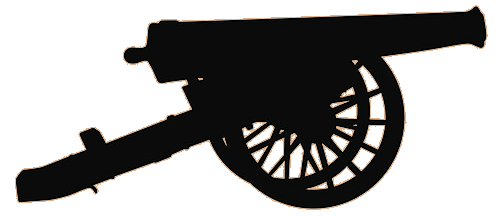

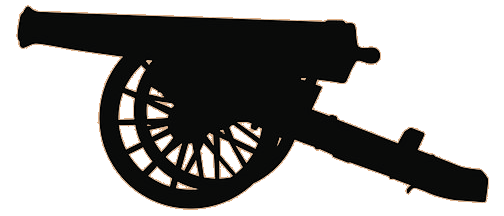

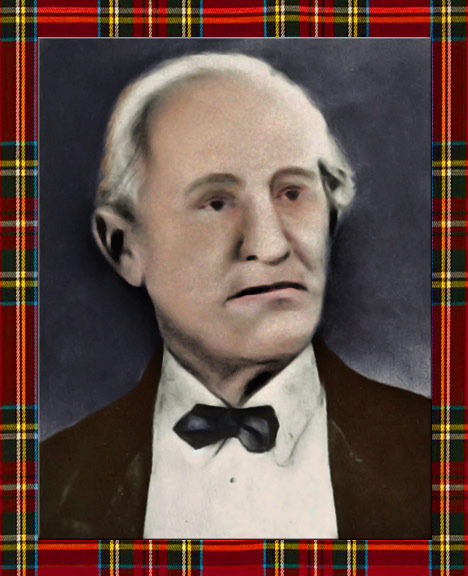




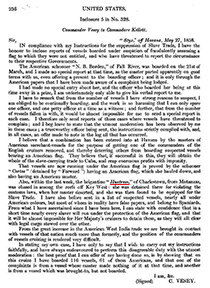
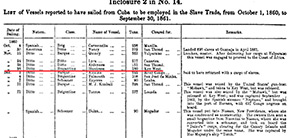














 VANLANDINGHAM,
Kyle Samuel, 57, who was a historian and genealogist, died
November 17, 2009, in a Denver hospital from the H1N1
virus, also known as swine flu. He is survived by his
mother, Jane Ernestine Alderman VanLandingham; and
brother, Larue Pierre VanLandingham and wife, Denise, of
DeFuniak Springs, Fla. He was preceded in death by his
father, Samuel Pierre VanLandingham.
VANLANDINGHAM,
Kyle Samuel, 57, who was a historian and genealogist, died
November 17, 2009, in a Denver hospital from the H1N1
virus, also known as swine flu. He is survived by his
mother, Jane Ernestine Alderman VanLandingham; and
brother, Larue Pierre VanLandingham and wife, Denise, of
DeFuniak Springs, Fla. He was preceded in death by his
father, Samuel Pierre VanLandingham.